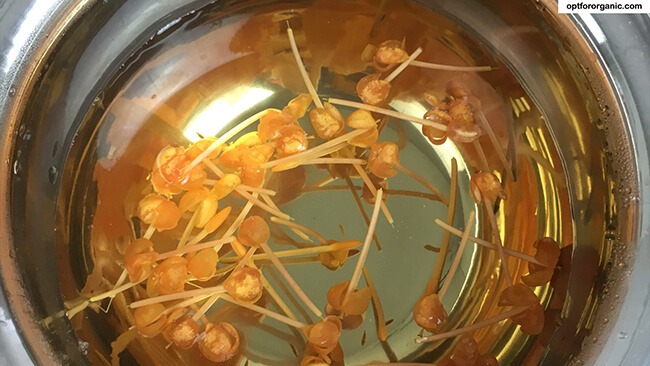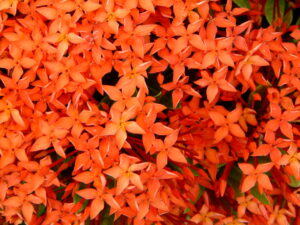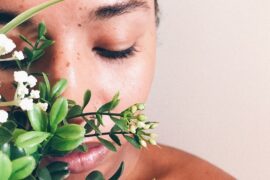Glossy Foliage for Glowing Skin

Jungle Geranium or Ixora coccinea is one of the most popular flowering plants of gardens and landscapes. Results from recent research studies carried out, reveal that Ixora coccinea is a potential candidate as the active ingredient of products for topical application as skin whitening and anti-ageing in cosmetic formulations, along with its traditional applications in the treatment of skin diseases.
Ixora coccinea, commonly known as ‘Paranti’ in Sanskrit, is one of the most popular of house and garden plants. A well-grown specimen of Paranti will definitely attract one’s attention. There are several varieties of Ixora worldwide. Paranti has varied medical applications in Ayurveda, Siddha and Folk medicine. It is widely found in Western Ghats of southern India and in Sri Lanka. The plant is traditionally found to be useful against many skin ailments like itching, chronic ulcers etc. It is also a good antiseptic and wound healing agent.
How does it look like?
It is a densely branched evergreen shrub growing up to 3 metres tall; stems are grayish-brown in colour, 3-4 cm in diameter. The leaves are ovate-oblong in shape with leathery or glossy texture. Inflorescence is dense, terminal corymbs with several scarlet red flowers. Fruits are berries, fleshy, globose in shape, chick pea sized, green in colour, turning crimson red when ripe. The fruits contain 2 seeds, oval shaped flat seeds, red in colour.
The wild Paranti produces flowers that are reddish-orange in colour. There are many cultivated varieties of Paranti plants with white, yellow, salmon or pink flowers prevalent.
Where it is found?
It is native to India and found in almost all tropical and sub-tropical regions of the world. In India it is extensively found in the West Coast, Southern parts and along the slopes in tropical areas with moderate annual rainfall.
How to grow it in your Garden?
Paranti is one of the finest flowering plants ensuring itself pre-eminent position in the garden. The large terminal trusses of scarlet-red flowers bloom from summer through rainy season that look strikingly beautiful adding to the vibrancy of any garden.
 t
t
Medicinal properties and Uses
Pharmacological studies suggest that the plant possesses properties of antioxidative, antibacterial (works against bacterial infections), gastro-protective (good for digestive system), hepato-protective (protects the Liver), anti-diarrhoeal, analgesic (reduces pain), anti-neoplastic (inhibiting or preventing the growth and spread of malignant cells like cancer cells) and chemo-preventive (the use of chemical agents to prevent the development of cancer) effects, thus lending scientific support to the plant’s ethno-medicinal uses.
Subject to medical condition the leaves, stem, fruits, flowers and roots are also used against various ailments in traditional Indian systems of medicine. The fruits and flowers are used to treat dysentery, haemoptysis (coughing blood), hypertension, menstrual irregularities, sprains, bronchitis, fever, sores, chronic ulcers, scabies and other skin diseases.
The concoction prepared by boiling its flowers with the leaves of Coldenia procumbens (Tripakshi), Centella asiatica (Manduka parni), and the stem bark of Madhuca longifolia (Madhuka), is mixed with coconut oil and then used as a wound healing agent.
The shade-dried flowers are processed in coconut oil is externally applied to reduce eczema.
Vernacular Names
Popularly known as Rukmini (Hindi), Paranti (Sanskrit), Kempu kepala gida (Kannada) Chethi (Malayalam), Raamabaanamu (Telugu), Vetchi (Tamil), Rangan (Bengali), Bakora (Marathi) and Jungle Geranium (English), Ixora coccinea belonging to the coffee family (Rubiaceae) is the fourth largest among the flowering plants.
Probably the Generic name ‘Ixora’ is believed to be derived from the Sanskrit word ‘Ishwara’ which means ‘God’ as it is offered to Gods in puja rituals. Specific epithet ‘coccinea’ means “scarlet-dyed” (Latin), referring to the colour of its flowers.
Self Help
For Skin Diseases
Chop handful flowers of Ixora coccinea, boil them in coconut oil, and use it over infected or damaged skin
For Leucorrhoea
Crush flowers of Ixora coccinea to make a paste, add 1 teaspoon of it in one glass of buttermilk, and have it twice a day for 2 months.
For Fever
Make a decoction with flowers of Ixora coccinea, have 20 ml of it once a day’ for 3 days or till fever persists.
For Dysentery
Grind 100 grams dried roots of Ixora coccinea with 25 grams of black pepper. Consume it by adding 20 grams of the powder in buttermilk. Have it twice a day
For Diarrhoea
Take 50 grams of root bark of Ixora coccinea, 30 grams of long pepper, grind them to make a powder, take 2 grams of this twice a day with luke warm water.
For Eczema
Shade dried flowers of Ixora coccinea are gently heated in coconut oil and the extract is applied externally to treat eczema. Flowers grinded with water applied in affected eczema area and bathing with water boiled with flowers is very useful in eczema.
For Allergic Asthma
Make a decoction with a handful of Ixora coccinea leaves in water, have it twice a day for two weeks to get rid of allergic asthma.
Disclaimer: The medical recommendations are not confirmed by clinical studies or classical references of any medical texts. Information is gathered from the practicing physicians.
Please Note: Saplings for Ixora coccinea and other medicinal plants are available for sale at I-AIM’s Herbal Garden and nursery, for more details, contact:
E-mail: [email protected]
Web link: http://envis.frlht.org/garden.php
Facebook: https://www.facebook.com/AmruthHerbalGardens



